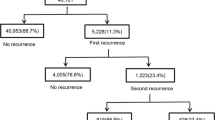Abstract
Background
Although there has been much debate over the fate of the gallbladder (GB) after endoscopic common bile duct (CBD) stone removal, subsequent cholecystectomy is generally recommended in patients with GB stones to prevent further biliary complications. The aims of this study were to assess the natural course of the patients with GB in situ after endoscopic CBD stone removal and to evaluate the necessity of prophylactic cholecystectomy.
Methods
Four hundred sixty-one patients who had undergone CBD stone removal at Yeungnam University Hospital between January 2000 and December 2004 were retrospectively analyzed, and 232 patients were ultimately enrolled in this study.
Results
The mean duration of follow-up was 73 (range = 7–126) months in the cholecystectomy group and 66 (6–127) months in the GB in situ group (p = 0.168). Ten patients (14.7 %) in the cholecystectomy group and 31 patients (18.9 %) in the GB in situ group developed recurrent CBD stones (p = 0.295). The highest percentage of recurrent CBD stones in both groups was that for brown stones (80 and 80.6 %). In the GB in situ group, cumulative recurrence rates of CBD stones were not significantly different between patients with GB stones and without GB stones (15.9 vs. 20 %, p = 0.798). However, the incidence of acute cholecystitis was significantly higher in patients with GB stones compared to patients without GB stones (13.6 vs. 2.5 %, p = 0.003).
Conclusions
Prophylactic cholecystectomy seems to be unnecessary in patients without GB stones after endoscopic sphincterotomy. However, in patients with GB stones, elective cholecystectomy or close observation is recommended due to the higher risk of cholecystitis.
Similar content being viewed by others
References
Classen M, Demling L (1974) Endoscopic sphincterotomy of the papilla of vater and extraction of stones from the choledochal duct (author’s transl). Dtsch Med Wochenschr 99:496–497
Kawai K, Akasaka Y, Murakami K, Tada M, Koli Y (1974) Endoscopic sphincterotomy of the ampulla of Vater. Gastrointest Endosc 20:148–151
Boerma D, Rauws EA, Keulemans YC, Janssen IM, Bolwerk CJ, Timmer R, Boerma EJ, Obertop H, Huibregtse K, Gouma DJ (2002) Wait-and-see policy or laparoscopic cholecystectomy after endoscopic sphincterotomy for bile-duct stones: a randomised trial. Lancet 360:761–765
Lai KH, Lin LF, Lo GH, Cheng JS, Huang RL, Lin CK, Huang JS, Hsu PI, Peng NJ, Ger LP (1999) Does cholecystectomy after endoscopic sphincterotomy prevent the recurrence of biliary complications? Gastrointest Endosc 49:483–487
Hill J, Martin DF, Tweedle DE (1991) Risks of leaving the gallbladder in situ after endoscopic sphincterotomy for bile duct stones. Br J Surg 78:554–557
Kullman E, Borch K, Dahlin LG, Liedberg G (1991) Long-term follow-up of patients with gallbladder in situ after endoscopic sphincterotomy for choledocholithiasis. Eur J Surg 157:131–135
Kwon SK, Lee BS, Kim NJ, Lee HY, Chae HB, Youn SJ, Park SM (2001) Is cholecystectomy necessary after ERCP for bile duct stones in patients with gallbladder in situ? Korean J Intern Med 16:254–259
Hammarstrom LE, Holmin T, Stridbeck H (1996) Endoscopic treatment of bile duct calculi in patients with gallbladder in situ: long-term outcome and factors. Scand J Gastroenterol 31:294–301
Neoptolemos JP, Carr-Locke DL, Fraser I, Fossard DP (1984) The management of common bile duct calculi by endoscopic sphincterotomy in patients with gallbladders in situ. Br J Surg 71:69–71
Welbourn CR, Beckly DE, Eyre-Brook IA (1995) Endoscopic sphincterotomy without cholecystectomy for gall stone pancreatitis. Gut 37:119–120
Archibald JD, Love JR, McAlister VC (2007) The role of prophylactic cholecystectomy versus deferral in the care of patients after endoscopic sphincterotomy. Can J Surg 50:19–23
Kang EH, Na YS, Lee SH, Choi TY, Shin WC, Lee JH, Choi WC, Kim KY (2000) Endoscopic treatment of bile duct calculi in patients with gallbladder in situ. Korean J Gastrointest Endosc 20:21–25
Kang JK, Park IS, Chung JB, Moon YM, Kim HG, Song SY, Lee JH, Cheong JY, Jung BG (1999) Factor influencing the recurrence of CBD stones after an endoscopic sphincteromy. Korean J Gastrointest Endosc 19:581–587
Park CW, Kim JH, Lee DJ, Kim KY, Suh JI, Kim TN, Chung MK (1997) A study of necessity for cholecystectomy after endoscopic common bile duct stone removal. Korean J Gastroenterol 29:659–666
Kim MH, Lim BC, Myung SJ, Lee SK, Ohrr HC, Kim YT, Roe IH, Kim JH, Chung JB, Kim CD, Shim CS, Yun YB, Min YI, Yang US, Kang JK (1999) Epidemiological study on Korean gallstone disease: a nationwide cooperative study. Dig Dis Sci 44:1674–1683
Yasui T, Takahata S, Kono H, Nagayoshi Y, Mori Y, Tsutsumi K, Sadakari Y, Ohtsuka T, Nakamura M, Tanaka M (2012) Is cholecystectomy necessary after endoscopic treatment of bile duct stones in patients older than 80 years of age? J Gastroenterol 47:65–70
Tanaka M, Takahata S, Konomi H, Matsunaga H, Yokohata K, Takeda T, Utsunomiya N, Ikeda S (1998) Long-term consequence of endoscopic sphincterotomy for bile duct stones. Gastrointest Endosc 48:465–469
Yi SY (2000) Recurrence of biliary symptoms after endoscopic sphincterotomy for choledocholithiasis in patients with gall bladder stones. J Gastroenterol Hepatol 15:661–664
Kageoka M, Watanabe F, Maruyama Y, Nagata K, Ohata A, Noda Y, Miwa I, Ikeya K (2009) Long-term prognosis of patients after endoscopic sphincterotomy for choledocholithiasis. Dig Endosc 21:170–175
Disclosures
Drs. Mei Lan Cui, Joon Hyun Cho, and Tae Nyeun Kim have no conflicts of interest or financial ties to disclose.
Author information
Authors and Affiliations
Corresponding author
Rights and permissions
About this article
Cite this article
Cui, M.L., Cho, J.H. & Kim, T.N. Long-term follow-up study of gallbladder in situ after endoscopic common duct stone removal in Korean patients. Surg Endosc 27, 1711–1716 (2013). https://doi.org/10.1007/s00464-012-2662-0
Received:
Accepted:
Published:
Issue Date:
DOI: https://doi.org/10.1007/s00464-012-2662-0




